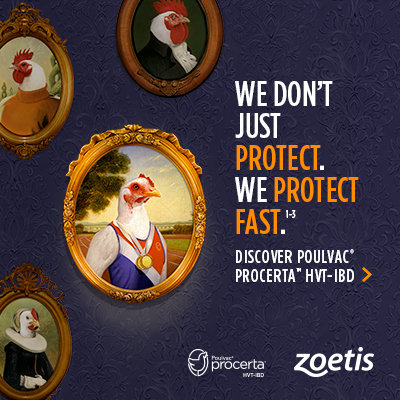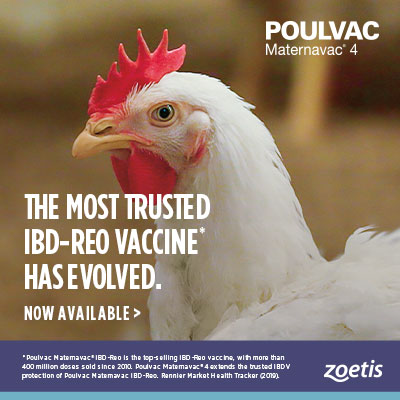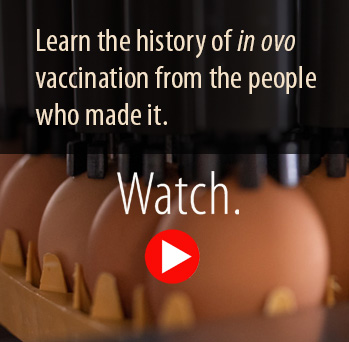Poulvac Procerta HVT-IBD offers early immunity, greater pullet uniformity in layers
An interview with John Brown, DVM, senior technical services veterinarian and layer specialist, Zoetis
Q: There are multiple vectored recombinant vaccines for infectious bursal disease virus (IBDV) on the market. What advantages does Poulvac® Procerta® HVT-IBD offer?
JB: When you get a flock of 300,000 chicks, you don’t know what their individual maternal antibody levels are. This creates the potential for a gap in protection between loss of maternal antibodies and onset of vaccine immunity, posing a substantial risk for young birds. In a study, Poulvac Procerta HVT-IBD helped close this gap by providing better, early protection compared to two competitor vaccines.1 Another study found that birds vaccinated with Poulvac Procerta HVT-IBD were protected from common IBDV challenges at 14 days of age,2 which is typically when maternal immunity disappears. Meanwhile, an additional study has demonstrated protection against very virulent IBDV as early as 12 days of age.3
Q: Why is early onset of immunity important with IBDV vaccination?
JB: IBDV is associated with severe immunosuppression and secondary bacterial infections, especially in young birds. When you’re looking at the effect of IBDV on birds’ overall immune systems, this earlier onset of immunity is huge.
Q: How does the vaccine work, and what enables it to provide early onset of immunity?
JB: The backbone of our vaccine is a herpesvirus of turkey (HVT), which replicates well and protects against Marek’s disease virus. The IBDV gene is inserted into the HVT backbone. Fast replication of the HVT, combined with strong expression of the IBDV gene, are largely responsible for the ability of the vaccine to provide effective early protection.
Q: Early protection is important, but how long is the vaccine effective?
JB: Our duration-of-immunity research showed 100% efficacy up to at least 63 days of age against standard IBDV.4 Protecting young birds against IBDV is important but so is protecting them throughout their life, since IBDV can cause immunosuppression in older birds too.
Q: How was immunity against IBDV achieved in layers before vectored recombinant vaccines came along?
JB: Previously, live vaccines were administered in an attempt to coincide with when maternal antibodies had degraded enough for the birds to respond to them. You’d have to give three, four different live vaccines in order to time that just right and get a really uniform flock. This is burdensome on the producer, and you’re still not sure of getting the results that you get with these vector vaccines.
If you don’t have that immunity against IBDV right, you have much more variable size of the bird during grow.5 That uniformity of their growth is really negatively impacted. As a result, you have birds that are coming into production early and others that are coming into production later, and you’re not getting your full genetic potential out of the birds.
Q: What change in bird uniformity might a producer expect to see by switching from live IBDV vaccination to a vectored vaccine?
JB: In layers, I have seen 80% to 90% uniformity in pullets with the vaccine, and without it, I see only 60% to 80% uniformity.
Q: How does increased uniformity in the layer flock translate into return on investment?
JB: Vectored vaccines are costlier than live vaccines, come without the same immunosuppressive effects, giving producers more chance of a uniform flock. At 16 weeks, they’re all going to come into production about the same time, and you’re going to get more sustained production. Ultimately, you’ll get more eggs and better livability, and this translates directly into profits.6
Q: Do vectored vaccines offer any other practical benefits for producers?
JB: Vectored vaccines eliminate the need to give the IBDV vaccines by spray or in the water. They allow the hatchery to handle vaccination, whether that’s injection of birds at 1 day of age or delivering it in ovo at 18 to 19 days. Every bird is going to get it because it’s injected.
It’s just so much easier on the producer. Labor is tough to find here in the US and elsewhere, so when you have to have somebody spray multiple times, that’s extra labor, when they could be doing other things more important for the birds.
Q: Do you see an accelerated move toward vector vaccines in the industry?
JB: In an ideal world, we could put everything on a vector product and just give one vaccine in the hatchery and be done with it. That’s never going to happen, but the more we can get effective vector products on HVT, and given at the hatchery, the more I think people will adopt those.
1 Data on file, Study Report No. B815R-US-19- B20, Zoetis LLC.
2 Data on file, Study Report No. B815RUS-19- B22. Zoetis LLC.
3 Hartman A, et al. Early onset of immunity and duration of immunity of a recombinant HVT-IBD vaccine against virulent, variant, and very virulent IBD. 63rd Am Assoc Avian Pathol. 2020.
4 Ibid.
5 Jackwood DJ, et al. A proposed nomenclature for infectious bursal disease virus isolates. Avian Pathol. 2018:47(6):576-584.
6 Prandini F, et al. Comparison of infectious bursal disease live vaccines and a HVT-IBD vector vaccine and their effects on the immune system of commercial layer pullets. Avian Pathol. 2016;45(1):114-125.
All trademarks are the property of Zoetis Services LLC or a related company or a licensor unless otherwise noted.
TOOLBOX, Issue 31
Toolbox is a series of interviews with veterinarians and other technical specialists about their experiences managing antimicrobials, vaccines and other tools for poultry health. It is produced by the editors of Poultry Health Today on behalf of the US Poultry Business of Zoetis.
BIO-00335
Feb 2022
Posted on June 1, 2022















